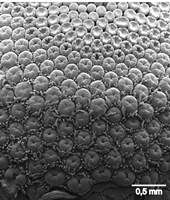Genetic research places flower shape on drawing board

Flowers such as sunflowers and gerberas are made up of two types of smaller flowers: ray and disk flowers. Dutch researcher Anneke Rijpkema has discovered the genes responsible for the distribution between these two types. This research result sheds light on the evolution of this type of flower and could possibly be used in agriculture.
There are two major types of flower in nature: single and composite. Single flowers such as orchids are exactly what they seem, namely a single flower. A composite flower, however, misleads the observer as it actually consists of hundreds of small flowers. For example a sunflower has sterile ray flowers along its edges that look like petals. The heart contains the more compact disk flowers, which are responsible for the seed production. Rijpkema investigated where these different types of flower originate from.
In the gerbera and sunflower –both composite flowers – Rijpkema discovered differences in activity between the CYC genes. These genes were discovered about ten years ago and are known to regulate the symmetry of flower shapes. The snapdragon (antirrhinum), which served as a model for the initial studies, contains two CYC genes. Aster-like flowers such as the gerbera and sunflower have got ten. Rijpkema's research revealed a group of CYC genes that is far more active in the ray flowers than in the disk flowers. This is even the case in very young flowers when the difference between both flower types is not visible yet. This indicates that these genes are important for the flower differentiation.
Based on her findings Rijpkema thinks that during their evolution in aster-like flowers the CYC genes acquired a new function. They determine where each floret comes. Natural variations in the genes have led to a huge diversity in the aster family, one of the biggest families in the plant kingdom. Insects are crazy about the flowers because they frequently pollinate these. 'The CYC genes have brought the asters to a higher level,' says Rijpkema.
Sunflowers and gerberas are important ornamental flowers. And sunflowers are also important for the production of vegetable oils. Could Rijpkema's discovery lead to the 'design' of sunflowers with even more seeds or gerberas that are even more beautiful still? The researcher is cautious but positive. 'It might be possible with the help of genetic modification. However, plant breeding is more likely. We now know which genes we need to look at in order to obtain a certain flower shape. By selecting natural or artificial mutations it must be possible to design flowers.' The researcher has already made the step to plant breeding. She now works for the company Rijk Zwaan that produces new vegetable varieties.
An article by Rijpkema about her research was published on Thursday 22 March in the scientific journal Molecular Biology and Evolution. Rijpkema carried out her research at the University of Helsinki.
















